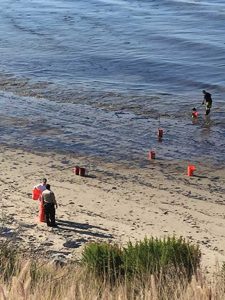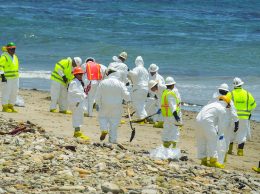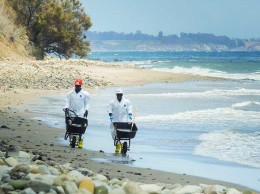Cry grows to stop new oil production in Santa Barbara County
IN THIS ARTICLE
- Energy Topic
- Elijah Brumback Author
By Elijah Brumback Friday, May 29th, 2015

A California Highway Patrol officer warns volunteers who showed up May 20 to clean up oil near Refugio State Beach from a 21,000-gallon pipeline spill to leave the area because it was too hazardous.
Photo by Debra Giles
The Refugio oil spill cleanup will keep area beaches closed at least until June 4, the number of wildlife affected continues to grow, Canada de Alegria to Coal Oil Point fisheries are off limits and a geyser of negative national media attention has tarnished the region’s pristine reputation.
The spill, which was the result of a ruptured onshore pipeline owned by Texas-based operator Plains All American Pipeline and caused an estimated 2,400 barrels of crude oil to leak on land and into the Pacific Ocean off the Gaviota coast on May 19, is the latest environmental disaster to befall Santa Barbara County.
The fallout from the spill has set the stage for a resurgence of clashes between fossil fuel industry leadership and clean energy advocates. With the physical evidence from the spill and mounting facts shedding light on Plains All American’s history as one of the nation’s worst pipeline operators, clean energy supporters might have the artillery they need to launch a major attack on the region’s oil interests.
The total extent of the damage to the environment remains unclear and the estimated economic impact is also still unknown as clean up crews tackle contaminated areas. What is apparent, however, are the reactions of various environmental groups, state and local officials, and tourism industry advocates.
For many the message is clear: no more oil production.
Environmental Response
Activist Paul Relis, who helped start the grassroots environmental movement with the Community Environmental Council after the massive 1969 Santa Barbara oil spill, is one of the biggest voices to decry major oil producers here and elsewhere.
“People have been asking me how the Refugio oil spill compares to the 1969 Santa Barbara spill. Really any spill of this magnitude is a tragedy, and the location on the Gaviota Coast could not be worse,” Relis said in statement. “But one major difference is that 45 years ago, we had no idea how to break our addiction to oil. Now we do. Now we have both the policy tools and the technology to make this transition. Those are two powerful drivers.”
Relis, who is board emeritus of the CEC and now works in the private sector, focusing on waste-derived bioenergy, is joined in his call for action against oil interests by the Environmental Defense Center and others.
“Unfortunately, with accidents and oil development, it is not a question of if, but of when. But to see this level of spill into such a sensitive and treasured environment is devastating to watch,” said EDC Executive Director Owen Bailey.
New projects held up
Coastal drilling applications from Venoco to drill off Ellwood at Platform Holly and Sunset-Exxon to drill from Vandenberg Air Force Base are new risks and the recent spill is a reminder “to make safer, cleaner and forward-looking decisions on energy production,” he said.
Dave Davis, current president and CEO of the CEC, called the spill a step backward but also a step forward in the fight to protect the coast.
In some ways, it appears those sentiments have reached those on the State Lands Commission. In light of Gov. Jerry Brown’s proclamation declaring a State of Emergency in Santa Barbara and to avoid any distraction from the efforts to address the recent oil spill response near Refugio Beach, the commission staff postponed its May 26 public scoping meeting for the Venoco South Ellwood field project to June 24.
For its part, Plains has taken responsibility for the spill and issued a release stating the company considers itself a very competent, experienced operator.
“Just like airline companies and every individual that drives an automobile, we have a goal of zero incidents. That said, despite the best planning and execution efforts, incidents do occur,” the company said in a press release.
In its defense, Plains claims that its numerous reported violations are due to its massive company size. As one of the largest midstream oil companies, the number of reported spills Plains has are higher than many of the smaller companies, the company said, noting that 99 percent of the other reporting companies were not only smaller than Plains, but that most of the smaller companies had less than half the number of miles of pipeline that Plains does.
Still, possible criminal charges could result from the spill. State Attorney General Kamala Harris said her office is working closely with state and federal partners on an investigation of the company’s conduct to ensure responsible parties are held accountable. Santa Barbara County District Attorney Joyce Dudley is also involved.
Legislation on the table
State Sen. Mike McGuire, D-Healdsburg, who represents 40 percent of the California coastline and its $40 billion economy, is working with state Sen. Hannah-Beth Jackson, D-Santa Barbara, on legislation that would close a loophole in the Coastal Sanctuary Act that currently allows the State Lands Commission to grant new leases for offshore oil and gas development.
Senate Bill 788 – The Coastal Protection Act – cites the possibility of new offshore oil leases in California and developers are already testing the political waters. The bill would forever ban any new oil drilling off of the California coast.
While the gears of legislative change turn at the state level, local businesses and other industry groups have responded to the spill with volunteers and donations. The EDC’s supporters have contributed more than $12,000 to support clean up efforts. Real estate software firm Yardi Systems has also offered to match every additional dollar the EDC raises up to an additional $25,000 for the Refugio response.
Media coverage
In relation to the media attention the spill has received, Visit Santa Barbara, the local travel and tourism organization, has been relatively quiet on the matter. But in a statement it said it is working closely with state partners, including Visit California, to communicate with international and targeted national travel trade media, reinforcing that Santa Barbara is open for business and largely unaffected outside of the immediate spill area.
Representatives from Plains All American did not respond to the Business Times’ requests for the number of financial and environmental claims made and their dollar amounts in relation to the spill so far.
“The full extent of the economic and environmental impacts of the current oil spill are not yet fully known, but it is imperative that improved environmental safeguards be quickly implemented, including tougher safety standards, additional investments in infrastructure, stricter local controls and increased inspections,” said Salud Carbajal, Santa Barbara County first district supervisor.
“On the Central Coast, it is important that we find the right balance for the future of our local economy and that we do not become overly reliant on any one sector. It is imperative that we continue to reduce our reliance on fossil fuels and accelerate our transition to green energy alternatives.”











